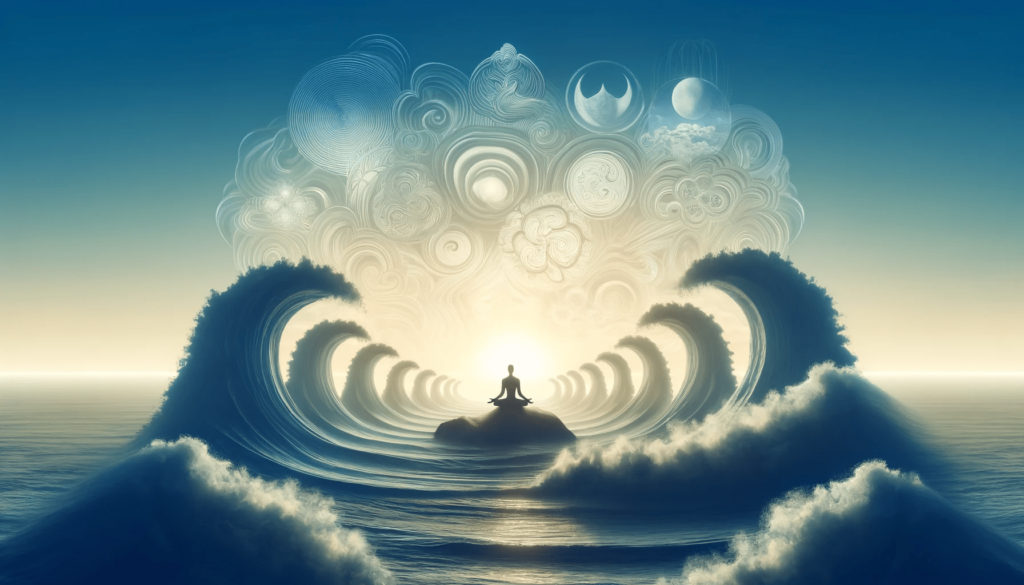Image generated by DALL-E
Within the vast, shimmering ocean of yogic wisdom, a beautiful metaphor beckons us to explore the depths of our being: the dance of the wave and the ocean. This timeless imagery, woven with poetic grace into the ancient Sanskrit scriptures of the Upanishads, illuminates the profound connection between our individual selves and the boundless source of all creation.
Have you ever stood in awe of the ocean, mesmerized by the endless rhythm of waves crashing upon the shore? In those moments, it’s easy to feel a humbling sense of our own smallness against the backdrop of such immense, perpetual motion. Yet, within that very ocean, each wave emerges as a unique expression of life, infinitely diverse in size, shape, and the intricate patterns that dance across its surface.
This is the heart of the wave-ocean metaphor: a celebration of both our unique individuality and our inseparable connection to the vastness of existence. Each of us, like a wave, is a singular, beautiful ripple upon the surface of life’s infinite waters. We have our own unique thoughts, emotions, and experiences that shape our journey.
Yet, just as the wave cannot exist without the ocean, our individual selves are inextricably linked to the boundless source from which we arise. This eternal, unchanging reality is the ground of all being, the unified field of consciousness that permeates and transcends all perceived boundaries. The ancient sages called it Brahman, the ultimate reality, while our individual selves are Atman, sparks of the divine.
This profound wisdom teaches us that we are not separate from the whole, but rather an integral part of it. Our uniqueness is a gift, a precious expression of the divine within us. But clinging stubbornly to our individuality, to the illusion of separateness, can lead to suffering and disconnection.
Instead, we are invited to embrace the full spectrum of our being — both the wave and the ocean, the individual and the universal. By recognizing and honoring both aspects of our existence, we can live a more balanced, joyful, and meaningful life.
The e wave-ocean imagery reveals the inherent dance between the two. Just as a wave arises, peaks, and is inevitably reabsorbed into the ocean’s expanse, so too do our individual identities emerge, manifest for a fleeting moment, and inevitably dissolve back into the ground of being from whence they arose.
Life itself follows this eternal rhythm of creation, movement and dissolution over and over, inviting us to embrace the full spectrum of our existence — to revel in the adventure of individuated self-expression while never forgetting our intrinsic unity with the infinite source.
In this light, the metaphor serves as a radiant guide for navigating our modern human experience. It encourages us to honor our personal journeys as ever-evolving waves — embracing our distinct talents, cultures, and callings with authenticity. Yet it simultaneously reminds us to look beyond the surface separations that so often breed conflict, transcending our petty divisions through the recognition of our shared belonging to the same boundless ocean of consciousness.
To rest in this awareness is to cultivate profound equanimity, empathy and an unwavering inner peace amidst the turbulence of the human experience. Whether riding the crest of exhilarating triumph or weathering the depths of sorrow, we need not anxiously cling to or resist the rhythms of life, but can instead surrender to the perpetual flow — the eternal dance between the one and the infinite from which it came.
It is perhaps this very dance that the ancient yogis sought to embody and express through physical practice itself. Each movement arises, expands, reaches its peak of expression, and ultimately dissolves again — a microcosmic reflection of the macrocosmic cycles of birth, growth, activity and death that endlessly recreate the universe.
To immerse oneself in this symbol system is to awaken to the profound truth hidden within every wave’s crest and trough — that we are simultaneously the drop and the ocean itself. In that remembered unity, we discover profound peace.

